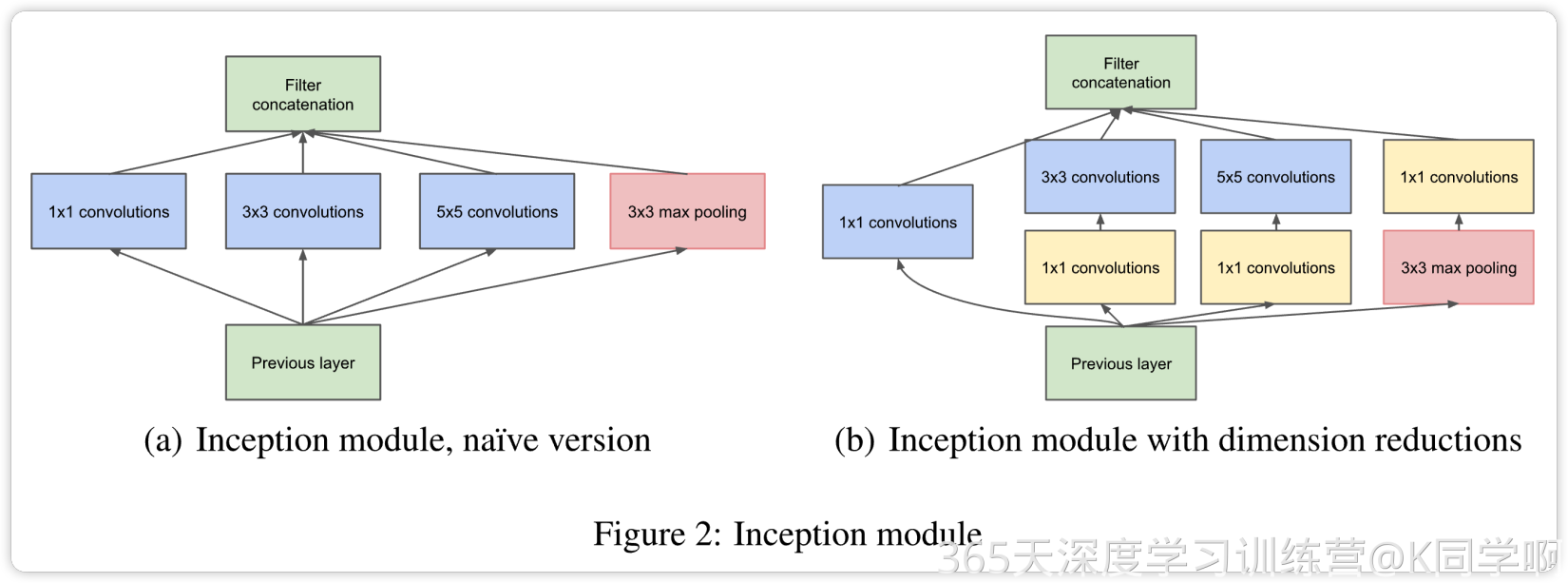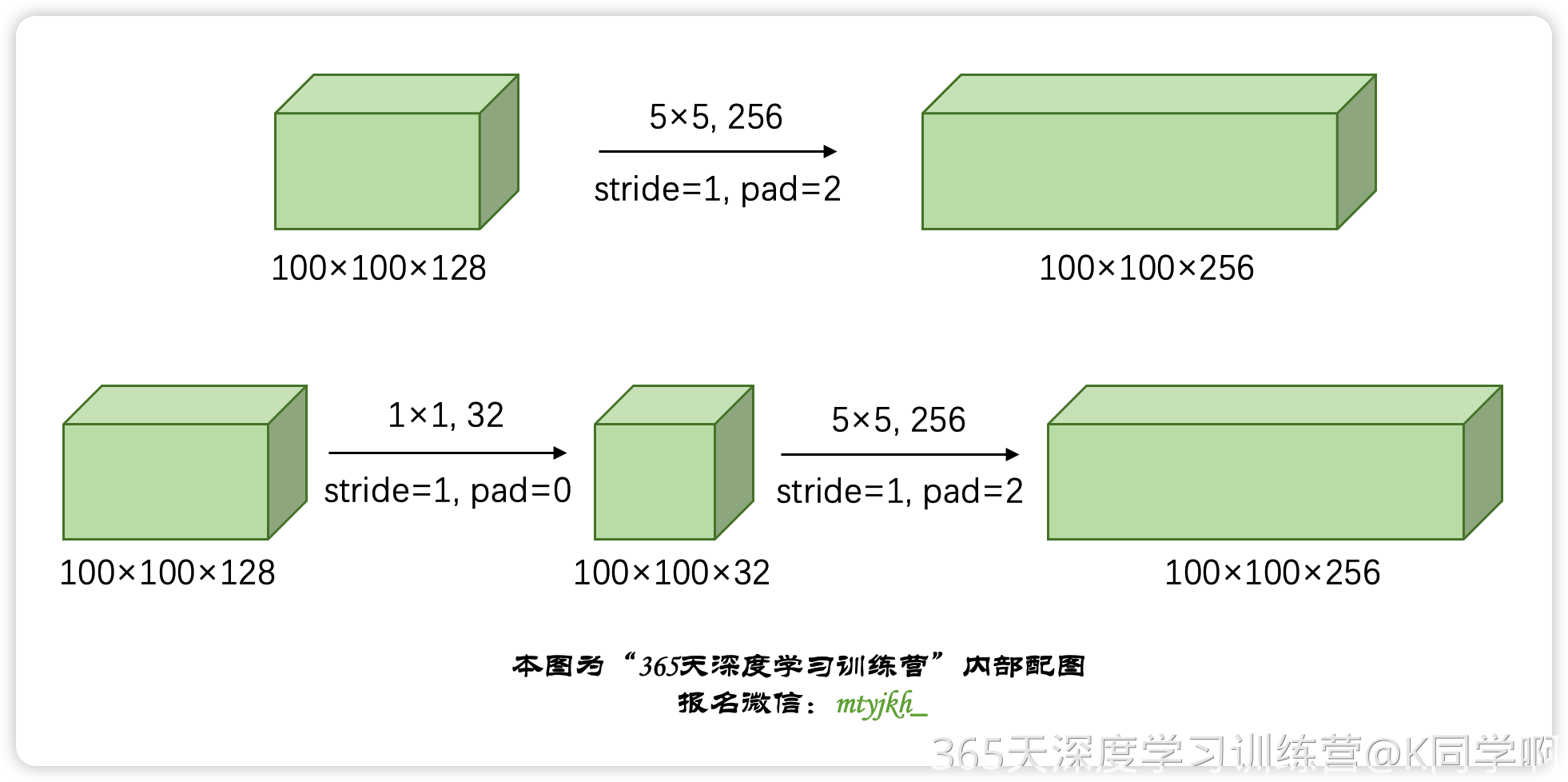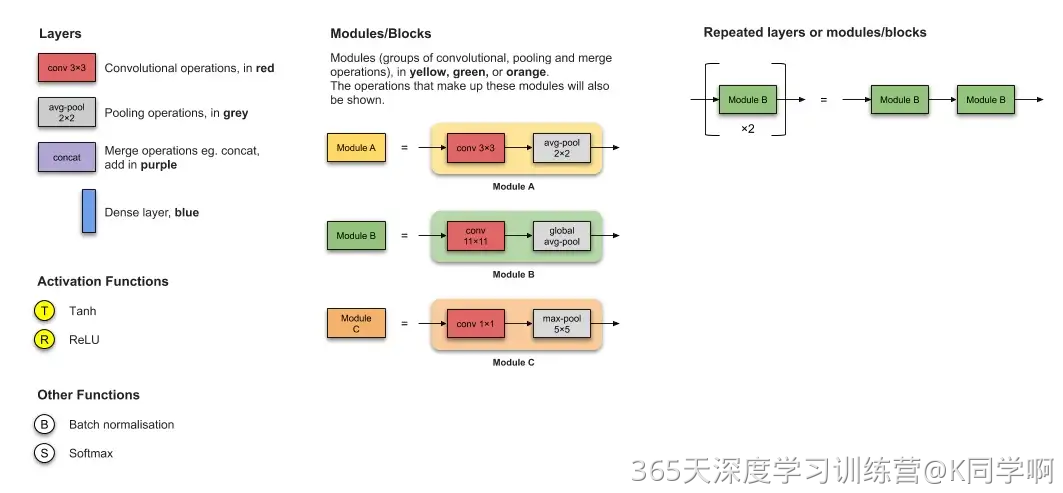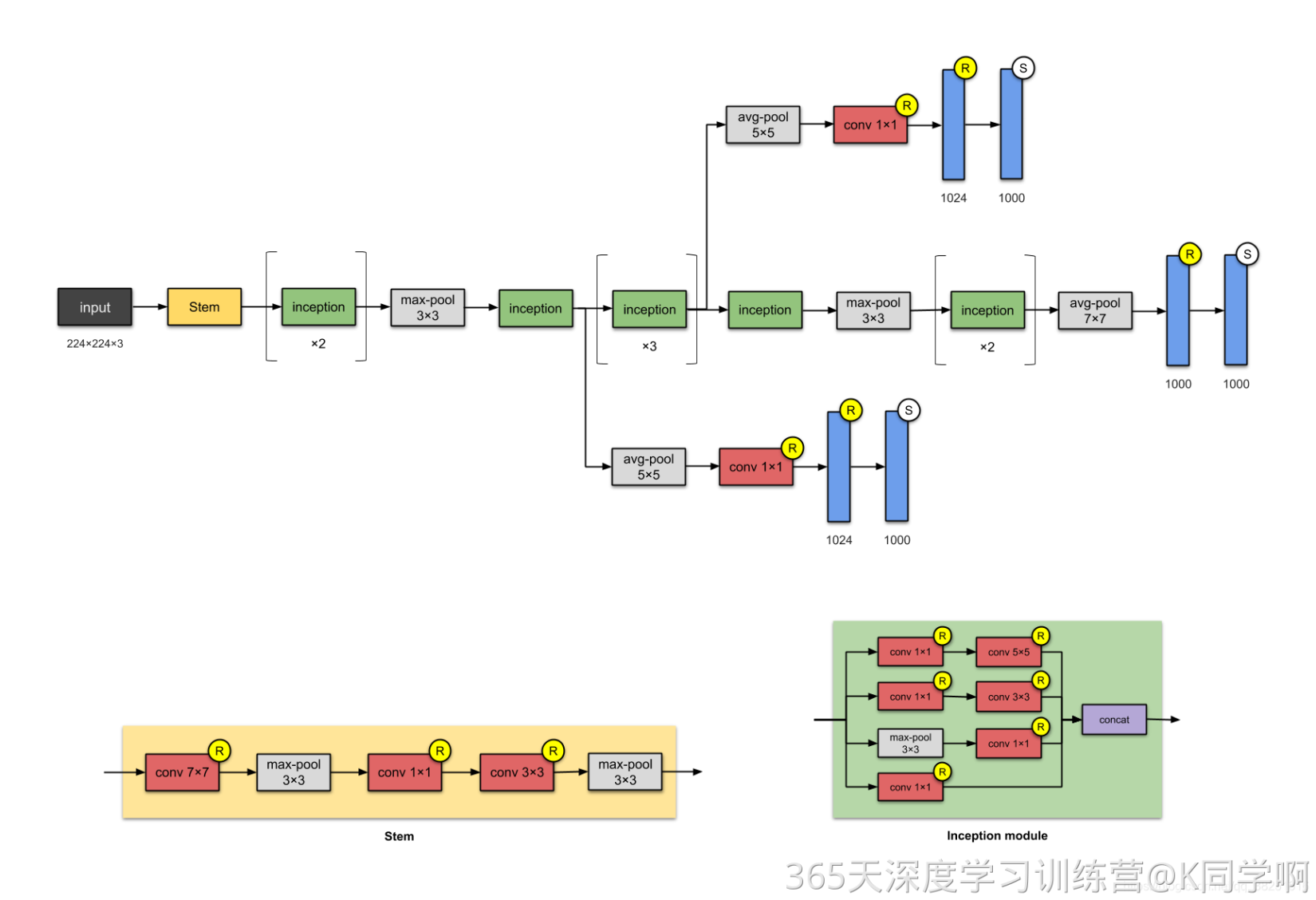J8、Inception v1算法实战与解析
- 🍨 本文为🔗365天深度学习训练营 中的学习记录博客
- 🍖 原作者:K同学啊 | 接辅导、项目定制
📌 本周任务: 1、了解并学习图2中的卷积层运算量的计算过程(🏐储备知识->卷积层运算量的计算,有我的推导过程,建议先自己手动推导,然后再看) 2、了解并学习卷积层的并行结构与1x1卷积核部分内容(重点) 3、尝试根据模型框架图写入相应的pytorch代码,并使用Inception v1完成猴痘病识别
一、Inception v1¶
Inception V1其实也就是GoogLeNet在2014年ILSVRC 比赛中的版本。 Inception V1有22层深,参数量为5M。同一时期的VGGNet性能和Inception V1差不多,但是参数量远大于Inception V1。
1、Inception Module¶
Inception Module是Inception V1的核心组成单元,提出了卷积层的并行结构,实现了在同一层就可以提取不同的特征,如下图中左边的模型 
这样的结构虽然可以提升性能,但是会面临计算量大(参数多)的问题。为改善这种现象,Inception Module借鉴Network-in-Network的思想,使用1x1的卷积核实现降维操作(也间接增加了网络的深度),以此来减小网络的参数量与计算量,如上图右边模型所示
可能这样并不能直观的理解这样一个1*1的卷积核结构能够节约多少的计算量
首先我们要知道卷积层参数的计算量通常等于: (卷积核的大小输入通道数) 输出通道数+输出通道数
params = channels~out~(kernel~w~ kernel~h~ * channels~in~) + bias
其中bias=channels~out~
在此举例说明:假如前一层的输出为100x100x128
- 直接经过256个5x5卷积核的卷积层之后(stride=1,pad=2),输出数据为100x100x256。其中,卷积层的参数为5x5x128x256+256
- 先经过32个1x1卷积核的卷积层(降低了通道数,不改变特征图尺寸),再经过具有256个5x5卷积核的卷积层,最终的输出数据仍为为100x100x256。这个卷积层的参数会变为1x1x128x32+5x5x32x256
- 参数数量减少为原来的约4分之一

最终,Inception Module由11卷积,33卷积,55卷积,33最大池化四个基本单元组成,对四个基本单元运算结果进行通道上组合,不同大小的卷积核赋予不同大小的感受野,从而提取到图像不同尺度的信息,进行融合,得到图像更好的表征,就是Inception Module的核心思想。
2、算法结构¶
实现的Inception v1网络结构图如下: 

除了主干以外,我们还能发现有两个辅助分支,作用有两点,
- 一是为了避免梯度消失,用于向前传导梯度。反向传播时如果有一层求导为0,链式求导结果则为0
- 二是将中间某一层输出用作分类,起到模型融合作用
实际测试时,这两个辅助softmax分支会被去掉,在后续模型的发展中,该方法被采用较少,可以直接绕过,重点学习卷积层的并行结构与1x1卷积核部分的内容即可
详细网络结构图: 
二、pytorch复现:只复现主支¶
1、导入必要的库¶
import torch
import torch.nn as nn
import torchvision.transforms as transforms
import torchvision
import torch.nn.functional as F
from torchvision import transforms, datasets
from sklearn.model_selection import KFold
from torch.optim.lr_scheduler import StepLR, MultiStepLR, LambdaLR, ExponentialLR, CosineAnnealingLR, ReduceLROnPlateau
import os,PIL,pathlib,random
device = torch.device("cuda" if torch.cuda.is_available() else "cpu")
device
device(type='cuda')
2、定义Inception类¶
class inception_block(nn.Module):
def __init__(self, in_channels, ch1x1, ch3x3red, ch3x3, ch5x5red, ch5x5, pool_proj):
# in_channels: 输入通道数(即输入特征图的深度)
# ch1x1: 1x1卷积核的输出通道数
# ch3x3red: 3x3卷积核前降维的1x1卷积核的输出通道数
# ch3x3: 3x3卷积核的输出通道数
# ch5x5red: 5x5卷积核前降维的1x1卷积核的输出通道数
# ch5x5: 5x5卷积核的输出通道数
# pool_proj: MaxPooling层后降维的1x1卷积核的输出通道数
super(inception_block, self).__init__()
# 1x1 conv branch
self.branch1 = nn.Sequential(
nn.Conv2d(in_channels, ch1x1, kernel_size=1),
nn.BatchNorm2d(ch1x1),
nn.ReLU(inplace=True)
)
# 1x1 conv -> 3x3 conv branch
self.branch2 = nn.Sequential(
nn.Conv2d(in_channels, ch3x3red, kernel_size=1),
nn.BatchNorm2d(ch3x3red),
nn.ReLU(inplace=True),
nn.Conv2d(ch3x3red, ch3x3, kernel_size=3, padding=1),
nn.BatchNorm2d(ch3x3),
nn.ReLU(inplace=True)
)
# 1x1 conv -> 5x5 conv branch
self.branch3 = nn.Sequential(
nn.Conv2d(in_channels, ch5x5red, kernel_size=1),
nn.BatchNorm2d(ch5x5red),
nn.ReLU(inplace=True),
nn.Conv2d(ch5x5red, ch5x5, kernel_size=5, padding=2),
nn.BatchNorm2d(ch5x5),
nn.ReLU(inplace=True)
)
# 3x3 max pooling -> 1x1 conv branch
self.branch4 = nn.Sequential(
nn.MaxPool2d(kernel_size=3, stride=1, padding=1),
nn.Conv2d(in_channels, pool_proj, kernel_size=1),
nn.BatchNorm2d(pool_proj),
nn.ReLU(inplace=True)
)
def forward(self, x):
# Compute forward pass through all branches and concatenate the output feature maps
branch1_output = self.branch1(x)
branch2_output = self.branch2(x)
branch3_output = self.branch3(x)
branch4_output = self.branch4(x)
outputs = [branch1_output, branch2_output, branch3_output, branch4_output]
return torch.cat(outputs, 1)
init 方法中,定义了四个分支,分别是:
- branch1,一个 1x1 卷积层;
- branch2,一个 1x1 卷积层接一个 3x3 卷积层;
- branch3,一个 1x1 卷积层接一个 5x5 卷积层;
- branch4,一个 3x3 最大池化层接一个 1x1 卷积层。
每个分支都包含了一些卷积层、批归一化层和激活函数。这些层都是 PyTorch 中的标准层,我们可以使用 nn.Conv2d、nn.BatchNorm2d 和 nn.ReLU 分别定义卷积层、批归一化层和 ReLU 激活函数
在 forward 方法中,我们计算从输入到所有分支的前向传递,并将所有分支的输出特征图拼接在一起。最后,我们返回拼接后的特征图
3、构建GoogLeNet¶
class GoogLeNet(nn.Module):
def __init__(self, num_classes=1000):
super(GoogLeNet, self).__init__()
self.conv1 = nn.Conv2d(3, 64, kernel_size=7, stride=2, padding=3)
self.maxpool1 = nn.MaxPool2d(kernel_size=3, stride=2, padding=1)
self.conv2 = nn.Conv2d(64, 64, kernel_size=1, stride=1, padding=0)
self.conv3 = nn.Conv2d(64, 192, kernel_size=3, stride=1, padding=1)
self.maxpool2 = nn.MaxPool2d(kernel_size=3, stride=2, padding=1)
self.inception3a = inception_block(192, 64, 96, 128, 16, 32, 32)
self.inception3b = inception_block(256, 128, 128, 192, 32, 96, 64)
self.maxpool3 = nn.MaxPool2d(kernel_size=3, stride=2, padding=1)
self.inception4a = inception_block(480, 192, 96, 208, 16, 48, 64)
self.inception4b = inception_block(512, 160, 112, 224, 24, 64, 64)
self.inception4c = inception_block(512, 128, 128, 256, 24, 64, 64)
self.inception4d = inception_block(512, 112, 144, 288, 32, 64, 64)
self.inception4e = inception_block(528, 256, 160, 320, 32, 128, 128)
self.maxpool4 = nn.MaxPool2d(kernel_size=3, stride=2, padding=1)
self.inception5a = inception_block(832, 256, 160, 320, 32, 128, 128)
self.inception5b=nn.Sequential(
inception_block(832, 384, 192, 384, 48, 128, 128),
nn.AvgPool2d(kernel_size=7,stride=1,padding=0),
nn.Dropout(0.4)
)
# 全连接网络层,用于分类
self.classifier = nn.Sequential(
nn.Linear(in_features=1024, out_features=1024),
nn.ReLU(),
nn.Linear(in_features=1024, out_features=num_classes),
nn.Softmax(dim=1)
)
def forward(self, x):
x = self.conv1(x)
x = F.relu(x)
x = self.maxpool1(x)
x = self.conv2(x)
x = F.relu(x)
x = self.conv3(x)
x = F.relu(x)
x = self.maxpool2(x)
x = self.inception3a(x)
x = self.inception3b(x)
x = self.maxpool3(x)
x = self.inception4a(x)
x = self.inception4b(x)
x = self.inception4c(x)
x = self.inception4d(x)
x = self.inception4e(x)
x = self.maxpool4(x)
x = self.inception5a(x)
x = self.inception5b(x)
x = torch.flatten(x, start_dim=1)
x = self.classifier(x)
4、打印模型结构¶
# 统计模型参数量以及其他指标
import torchsummary
# 调用并将模型转移到GPU中
model = GoogLeNet().to(device)
# 显示网络结构
torchsummary.summary(model, (3, 224, 224)) # 输入形状设置为 (3, 224, 224),表示模型的输入图片大小为 $3 \times 224 \times 224$
print(model)
----------------------------------------------------------------
Layer (type) Output Shape Param #
================================================================
Conv2d-1 [-1, 64, 112, 112] 9,472
MaxPool2d-2 [-1, 64, 56, 56] 0
Conv2d-3 [-1, 64, 56, 56] 4,160
Conv2d-4 [-1, 192, 56, 56] 110,784
MaxPool2d-5 [-1, 192, 28, 28] 0
Conv2d-6 [-1, 64, 28, 28] 12,352
BatchNorm2d-7 [-1, 64, 28, 28] 128
ReLU-8 [-1, 64, 28, 28] 0
Conv2d-9 [-1, 96, 28, 28] 18,528
BatchNorm2d-10 [-1, 96, 28, 28] 192
ReLU-11 [-1, 96, 28, 28] 0
Conv2d-12 [-1, 128, 28, 28] 110,720
BatchNorm2d-13 [-1, 128, 28, 28] 256
ReLU-14 [-1, 128, 28, 28] 0
Conv2d-15 [-1, 16, 28, 28] 3,088
BatchNorm2d-16 [-1, 16, 28, 28] 32
ReLU-17 [-1, 16, 28, 28] 0
Conv2d-18 [-1, 32, 28, 28] 12,832
BatchNorm2d-19 [-1, 32, 28, 28] 64
ReLU-20 [-1, 32, 28, 28] 0
MaxPool2d-21 [-1, 192, 28, 28] 0
Conv2d-22 [-1, 32, 28, 28] 6,176
BatchNorm2d-23 [-1, 32, 28, 28] 64
ReLU-24 [-1, 32, 28, 28] 0
inception_block-25 [-1, 256, 28, 28] 0
Conv2d-26 [-1, 128, 28, 28] 32,896
BatchNorm2d-27 [-1, 128, 28, 28] 256
ReLU-28 [-1, 128, 28, 28] 0
Conv2d-29 [-1, 128, 28, 28] 32,896
BatchNorm2d-30 [-1, 128, 28, 28] 256
ReLU-31 [-1, 128, 28, 28] 0
Conv2d-32 [-1, 192, 28, 28] 221,376
BatchNorm2d-33 [-1, 192, 28, 28] 384
ReLU-34 [-1, 192, 28, 28] 0
Conv2d-35 [-1, 32, 28, 28] 8,224
BatchNorm2d-36 [-1, 32, 28, 28] 64
ReLU-37 [-1, 32, 28, 28] 0
Conv2d-38 [-1, 96, 28, 28] 76,896
BatchNorm2d-39 [-1, 96, 28, 28] 192
ReLU-40 [-1, 96, 28, 28] 0
MaxPool2d-41 [-1, 256, 28, 28] 0
Conv2d-42 [-1, 64, 28, 28] 16,448
BatchNorm2d-43 [-1, 64, 28, 28] 128
ReLU-44 [-1, 64, 28, 28] 0
inception_block-45 [-1, 480, 28, 28] 0
MaxPool2d-46 [-1, 480, 14, 14] 0
Conv2d-47 [-1, 192, 14, 14] 92,352
BatchNorm2d-48 [-1, 192, 14, 14] 384
ReLU-49 [-1, 192, 14, 14] 0
Conv2d-50 [-1, 96, 14, 14] 46,176
BatchNorm2d-51 [-1, 96, 14, 14] 192
ReLU-52 [-1, 96, 14, 14] 0
Conv2d-53 [-1, 208, 14, 14] 179,920
BatchNorm2d-54 [-1, 208, 14, 14] 416
ReLU-55 [-1, 208, 14, 14] 0
Conv2d-56 [-1, 16, 14, 14] 7,696
BatchNorm2d-57 [-1, 16, 14, 14] 32
ReLU-58 [-1, 16, 14, 14] 0
Conv2d-59 [-1, 48, 14, 14] 19,248
BatchNorm2d-60 [-1, 48, 14, 14] 96
ReLU-61 [-1, 48, 14, 14] 0
MaxPool2d-62 [-1, 480, 14, 14] 0
Conv2d-63 [-1, 64, 14, 14] 30,784
BatchNorm2d-64 [-1, 64, 14, 14] 128
ReLU-65 [-1, 64, 14, 14] 0
inception_block-66 [-1, 512, 14, 14] 0
Conv2d-67 [-1, 160, 14, 14] 82,080
BatchNorm2d-68 [-1, 160, 14, 14] 320
ReLU-69 [-1, 160, 14, 14] 0
Conv2d-70 [-1, 112, 14, 14] 57,456
BatchNorm2d-71 [-1, 112, 14, 14] 224
ReLU-72 [-1, 112, 14, 14] 0
Conv2d-73 [-1, 224, 14, 14] 226,016
BatchNorm2d-74 [-1, 224, 14, 14] 448
ReLU-75 [-1, 224, 14, 14] 0
Conv2d-76 [-1, 24, 14, 14] 12,312
BatchNorm2d-77 [-1, 24, 14, 14] 48
ReLU-78 [-1, 24, 14, 14] 0
Conv2d-79 [-1, 64, 14, 14] 38,464
BatchNorm2d-80 [-1, 64, 14, 14] 128
ReLU-81 [-1, 64, 14, 14] 0
MaxPool2d-82 [-1, 512, 14, 14] 0
Conv2d-83 [-1, 64, 14, 14] 32,832
BatchNorm2d-84 [-1, 64, 14, 14] 128
ReLU-85 [-1, 64, 14, 14] 0
inception_block-86 [-1, 512, 14, 14] 0
Conv2d-87 [-1, 128, 14, 14] 65,664
BatchNorm2d-88 [-1, 128, 14, 14] 256
ReLU-89 [-1, 128, 14, 14] 0
Conv2d-90 [-1, 128, 14, 14] 65,664
BatchNorm2d-91 [-1, 128, 14, 14] 256
ReLU-92 [-1, 128, 14, 14] 0
Conv2d-93 [-1, 256, 14, 14] 295,168
BatchNorm2d-94 [-1, 256, 14, 14] 512
ReLU-95 [-1, 256, 14, 14] 0
Conv2d-96 [-1, 24, 14, 14] 12,312
BatchNorm2d-97 [-1, 24, 14, 14] 48
ReLU-98 [-1, 24, 14, 14] 0
Conv2d-99 [-1, 64, 14, 14] 38,464
BatchNorm2d-100 [-1, 64, 14, 14] 128
ReLU-101 [-1, 64, 14, 14] 0
MaxPool2d-102 [-1, 512, 14, 14] 0
Conv2d-103 [-1, 64, 14, 14] 32,832
BatchNorm2d-104 [-1, 64, 14, 14] 128
ReLU-105 [-1, 64, 14, 14] 0
inception_block-106 [-1, 512, 14, 14] 0
Conv2d-107 [-1, 112, 14, 14] 57,456
BatchNorm2d-108 [-1, 112, 14, 14] 224
ReLU-109 [-1, 112, 14, 14] 0
Conv2d-110 [-1, 144, 14, 14] 73,872
BatchNorm2d-111 [-1, 144, 14, 14] 288
ReLU-112 [-1, 144, 14, 14] 0
Conv2d-113 [-1, 288, 14, 14] 373,536
BatchNorm2d-114 [-1, 288, 14, 14] 576
ReLU-115 [-1, 288, 14, 14] 0
Conv2d-116 [-1, 32, 14, 14] 16,416
BatchNorm2d-117 [-1, 32, 14, 14] 64
ReLU-118 [-1, 32, 14, 14] 0
Conv2d-119 [-1, 64, 14, 14] 51,264
BatchNorm2d-120 [-1, 64, 14, 14] 128
ReLU-121 [-1, 64, 14, 14] 0
MaxPool2d-122 [-1, 512, 14, 14] 0
Conv2d-123 [-1, 64, 14, 14] 32,832
BatchNorm2d-124 [-1, 64, 14, 14] 128
ReLU-125 [-1, 64, 14, 14] 0
inception_block-126 [-1, 528, 14, 14] 0
Conv2d-127 [-1, 256, 14, 14] 135,424
BatchNorm2d-128 [-1, 256, 14, 14] 512
ReLU-129 [-1, 256, 14, 14] 0
Conv2d-130 [-1, 160, 14, 14] 84,640
BatchNorm2d-131 [-1, 160, 14, 14] 320
ReLU-132 [-1, 160, 14, 14] 0
Conv2d-133 [-1, 320, 14, 14] 461,120
BatchNorm2d-134 [-1, 320, 14, 14] 640
ReLU-135 [-1, 320, 14, 14] 0
Conv2d-136 [-1, 32, 14, 14] 16,928
BatchNorm2d-137 [-1, 32, 14, 14] 64
ReLU-138 [-1, 32, 14, 14] 0
Conv2d-139 [-1, 128, 14, 14] 102,528
BatchNorm2d-140 [-1, 128, 14, 14] 256
ReLU-141 [-1, 128, 14, 14] 0
MaxPool2d-142 [-1, 528, 14, 14] 0
Conv2d-143 [-1, 128, 14, 14] 67,712
BatchNorm2d-144 [-1, 128, 14, 14] 256
ReLU-145 [-1, 128, 14, 14] 0
inception_block-146 [-1, 832, 14, 14] 0
MaxPool2d-147 [-1, 832, 7, 7] 0
Conv2d-148 [-1, 256, 7, 7] 213,248
BatchNorm2d-149 [-1, 256, 7, 7] 512
ReLU-150 [-1, 256, 7, 7] 0
Conv2d-151 [-1, 160, 7, 7] 133,280
BatchNorm2d-152 [-1, 160, 7, 7] 320
ReLU-153 [-1, 160, 7, 7] 0
Conv2d-154 [-1, 320, 7, 7] 461,120
BatchNorm2d-155 [-1, 320, 7, 7] 640
ReLU-156 [-1, 320, 7, 7] 0
Conv2d-157 [-1, 32, 7, 7] 26,656
BatchNorm2d-158 [-1, 32, 7, 7] 64
ReLU-159 [-1, 32, 7, 7] 0
Conv2d-160 [-1, 128, 7, 7] 102,528
BatchNorm2d-161 [-1, 128, 7, 7] 256
ReLU-162 [-1, 128, 7, 7] 0
MaxPool2d-163 [-1, 832, 7, 7] 0
Conv2d-164 [-1, 128, 7, 7] 106,624
BatchNorm2d-165 [-1, 128, 7, 7] 256
ReLU-166 [-1, 128, 7, 7] 0
inception_block-167 [-1, 832, 7, 7] 0
Conv2d-168 [-1, 384, 7, 7] 319,872
BatchNorm2d-169 [-1, 384, 7, 7] 768
ReLU-170 [-1, 384, 7, 7] 0
Conv2d-171 [-1, 192, 7, 7] 159,936
BatchNorm2d-172 [-1, 192, 7, 7] 384
ReLU-173 [-1, 192, 7, 7] 0
Conv2d-174 [-1, 384, 7, 7] 663,936
BatchNorm2d-175 [-1, 384, 7, 7] 768
ReLU-176 [-1, 384, 7, 7] 0
Conv2d-177 [-1, 48, 7, 7] 39,984
BatchNorm2d-178 [-1, 48, 7, 7] 96
ReLU-179 [-1, 48, 7, 7] 0
Conv2d-180 [-1, 128, 7, 7] 153,728
BatchNorm2d-181 [-1, 128, 7, 7] 256
ReLU-182 [-1, 128, 7, 7] 0
MaxPool2d-183 [-1, 832, 7, 7] 0
Conv2d-184 [-1, 128, 7, 7] 106,624
BatchNorm2d-185 [-1, 128, 7, 7] 256
ReLU-186 [-1, 128, 7, 7] 0
inception_block-187 [-1, 1024, 7, 7] 0
AvgPool2d-188 [-1, 1024, 1, 1] 0
Dropout-189 [-1, 1024, 1, 1] 0
Linear-190 [-1, 1024] 1,049,600
ReLU-191 [-1, 1024] 0
Linear-192 [-1, 1000] 1,025,000
Softmax-193 [-1, 1000] 0
================================================================
Total params: 8,062,072
Trainable params: 8,062,072
Non-trainable params: 0
----------------------------------------------------------------
Input size (MB): 0.57
Forward/backward pass size (MB): 69.63
Params size (MB): 30.75
Estimated Total Size (MB): 100.96
----------------------------------------------------------------
GoogLeNet(
(conv1): Conv2d(3, 64, kernel_size=(7, 7), stride=(2, 2), padding=(3, 3))
(maxpool1): MaxPool2d(kernel_size=3, stride=2, padding=1, dilation=1, ceil_mode=False)
(conv2): Conv2d(64, 64, kernel_size=(1, 1), stride=(1, 1))
(conv3): Conv2d(64, 192, kernel_size=(3, 3), stride=(1, 1), padding=(1, 1))
(maxpool2): MaxPool2d(kernel_size=3, stride=2, padding=1, dilation=1, ceil_mode=False)
(inception3a): inception_block(
(branch1): Sequential(
(0): Conv2d(192, 64, kernel_size=(1, 1), stride=(1, 1))
(1): BatchNorm2d(64, eps=1e-05, momentum=0.1, affine=True, track_running_stats=True)
(2): ReLU(inplace=True)
)
(branch2): Sequential(
(0): Conv2d(192, 96, kernel_size=(1, 1), stride=(1, 1))
(1): BatchNorm2d(96, eps=1e-05, momentum=0.1, affine=True, track_running_stats=True)
(2): ReLU(inplace=True)
(3): Conv2d(96, 128, kernel_size=(3, 3), stride=(1, 1), padding=(1, 1))
(4): BatchNorm2d(128, eps=1e-05, momentum=0.1, affine=True, track_running_stats=True)
(5): ReLU(inplace=True)
)
(branch3): Sequential(
(0): Conv2d(192, 16, kernel_size=(1, 1), stride=(1, 1))
(1): BatchNorm2d(16, eps=1e-05, momentum=0.1, affine=True, track_running_stats=True)
(2): ReLU(inplace=True)
(3): Conv2d(16, 32, kernel_size=(5, 5), stride=(1, 1), padding=(2, 2))
(4): BatchNorm2d(32, eps=1e-05, momentum=0.1, affine=True, track_running_stats=True)
(5): ReLU(inplace=True)
)
(branch4): Sequential(
(0): MaxPool2d(kernel_size=3, stride=1, padding=1, dilation=1, ceil_mode=False)
(1): Conv2d(192, 32, kernel_size=(1, 1), stride=(1, 1))
(2): BatchNorm2d(32, eps=1e-05, momentum=0.1, affine=True, track_running_stats=True)
(3): ReLU(inplace=True)
)
)
(inception3b): inception_block(
(branch1): Sequential(
(0): Conv2d(256, 128, kernel_size=(1, 1), stride=(1, 1))
(1): BatchNorm2d(128, eps=1e-05, momentum=0.1, affine=True, track_running_stats=True)
(2): ReLU(inplace=True)
)
(branch2): Sequential(
(0): Conv2d(256, 128, kernel_size=(1, 1), stride=(1, 1))
(1): BatchNorm2d(128, eps=1e-05, momentum=0.1, affine=True, track_running_stats=True)
(2): ReLU(inplace=True)
(3): Conv2d(128, 192, kernel_size=(3, 3), stride=(1, 1), padding=(1, 1))
(4): BatchNorm2d(192, eps=1e-05, momentum=0.1, affine=True, track_running_stats=True)
(5): ReLU(inplace=True)
)
(branch3): Sequential(
(0): Conv2d(256, 32, kernel_size=(1, 1), stride=(1, 1))
(1): BatchNorm2d(32, eps=1e-05, momentum=0.1, affine=True, track_running_stats=True)
(2): ReLU(inplace=True)
(3): Conv2d(32, 96, kernel_size=(5, 5), stride=(1, 1), padding=(2, 2))
(4): BatchNorm2d(96, eps=1e-05, momentum=0.1, affine=True, track_running_stats=True)
(5): ReLU(inplace=True)
)
(branch4): Sequential(
(0): MaxPool2d(kernel_size=3, stride=1, padding=1, dilation=1, ceil_mode=False)
(1): Conv2d(256, 64, kernel_size=(1, 1), stride=(1, 1))
(2): BatchNorm2d(64, eps=1e-05, momentum=0.1, affine=True, track_running_stats=True)
(3): ReLU(inplace=True)
)
)
(maxpool3): MaxPool2d(kernel_size=3, stride=2, padding=1, dilation=1, ceil_mode=False)
(inception4a): inception_block(
(branch1): Sequential(
(0): Conv2d(480, 192, kernel_size=(1, 1), stride=(1, 1))
(1): BatchNorm2d(192, eps=1e-05, momentum=0.1, affine=True, track_running_stats=True)
(2): ReLU(inplace=True)
)
(branch2): Sequential(
(0): Conv2d(480, 96, kernel_size=(1, 1), stride=(1, 1))
(1): BatchNorm2d(96, eps=1e-05, momentum=0.1, affine=True, track_running_stats=True)
(2): ReLU(inplace=True)
(3): Conv2d(96, 208, kernel_size=(3, 3), stride=(1, 1), padding=(1, 1))
(4): BatchNorm2d(208, eps=1e-05, momentum=0.1, affine=True, track_running_stats=True)
(5): ReLU(inplace=True)
)
(branch3): Sequential(
(0): Conv2d(480, 16, kernel_size=(1, 1), stride=(1, 1))
(1): BatchNorm2d(16, eps=1e-05, momentum=0.1, affine=True, track_running_stats=True)
(2): ReLU(inplace=True)
(3): Conv2d(16, 48, kernel_size=(5, 5), stride=(1, 1), padding=(2, 2))
(4): BatchNorm2d(48, eps=1e-05, momentum=0.1, affine=True, track_running_stats=True)
(5): ReLU(inplace=True)
)
(branch4): Sequential(
(0): MaxPool2d(kernel_size=3, stride=1, padding=1, dilation=1, ceil_mode=False)
(1): Conv2d(480, 64, kernel_size=(1, 1), stride=(1, 1))
(2): BatchNorm2d(64, eps=1e-05, momentum=0.1, affine=True, track_running_stats=True)
(3): ReLU(inplace=True)
)
)
(inception4b): inception_block(
(branch1): Sequential(
(0): Conv2d(512, 160, kernel_size=(1, 1), stride=(1, 1))
(1): BatchNorm2d(160, eps=1e-05, momentum=0.1, affine=True, track_running_stats=True)
(2): ReLU(inplace=True)
)
(branch2): Sequential(
(0): Conv2d(512, 112, kernel_size=(1, 1), stride=(1, 1))
(1): BatchNorm2d(112, eps=1e-05, momentum=0.1, affine=True, track_running_stats=True)
(2): ReLU(inplace=True)
(3): Conv2d(112, 224, kernel_size=(3, 3), stride=(1, 1), padding=(1, 1))
(4): BatchNorm2d(224, eps=1e-05, momentum=0.1, affine=True, track_running_stats=True)
(5): ReLU(inplace=True)
)
(branch3): Sequential(
(0): Conv2d(512, 24, kernel_size=(1, 1), stride=(1, 1))
(1): BatchNorm2d(24, eps=1e-05, momentum=0.1, affine=True, track_running_stats=True)
(2): ReLU(inplace=True)
(3): Conv2d(24, 64, kernel_size=(5, 5), stride=(1, 1), padding=(2, 2))
(4): BatchNorm2d(64, eps=1e-05, momentum=0.1, affine=True, track_running_stats=True)
(5): ReLU(inplace=True)
)
(branch4): Sequential(
(0): MaxPool2d(kernel_size=3, stride=1, padding=1, dilation=1, ceil_mode=False)
(1): Conv2d(512, 64, kernel_size=(1, 1), stride=(1, 1))
(2): BatchNorm2d(64, eps=1e-05, momentum=0.1, affine=True, track_running_stats=True)
(3): ReLU(inplace=True)
)
)
(inception4c): inception_block(
(branch1): Sequential(
(0): Conv2d(512, 128, kernel_size=(1, 1), stride=(1, 1))
(1): BatchNorm2d(128, eps=1e-05, momentum=0.1, affine=True, track_running_stats=True)
(2): ReLU(inplace=True)
)
(branch2): Sequential(
(0): Conv2d(512, 128, kernel_size=(1, 1), stride=(1, 1))
(1): BatchNorm2d(128, eps=1e-05, momentum=0.1, affine=True, track_running_stats=True)
(2): ReLU(inplace=True)
(3): Conv2d(128, 256, kernel_size=(3, 3), stride=(1, 1), padding=(1, 1))
(4): BatchNorm2d(256, eps=1e-05, momentum=0.1, affine=True, track_running_stats=True)
(5): ReLU(inplace=True)
)
(branch3): Sequential(
(0): Conv2d(512, 24, kernel_size=(1, 1), stride=(1, 1))
(1): BatchNorm2d(24, eps=1e-05, momentum=0.1, affine=True, track_running_stats=True)
(2): ReLU(inplace=True)
(3): Conv2d(24, 64, kernel_size=(5, 5), stride=(1, 1), padding=(2, 2))
(4): BatchNorm2d(64, eps=1e-05, momentum=0.1, affine=True, track_running_stats=True)
(5): ReLU(inplace=True)
)
(branch4): Sequential(
(0): MaxPool2d(kernel_size=3, stride=1, padding=1, dilation=1, ceil_mode=False)
(1): Conv2d(512, 64, kernel_size=(1, 1), stride=(1, 1))
(2): BatchNorm2d(64, eps=1e-05, momentum=0.1, affine=True, track_running_stats=True)
(3): ReLU(inplace=True)
)
)
(inception4d): inception_block(
(branch1): Sequential(
(0): Conv2d(512, 112, kernel_size=(1, 1), stride=(1, 1))
(1): BatchNorm2d(112, eps=1e-05, momentum=0.1, affine=True, track_running_stats=True)
(2): ReLU(inplace=True)
)
(branch2): Sequential(
(0): Conv2d(512, 144, kernel_size=(1, 1), stride=(1, 1))
(1): BatchNorm2d(144, eps=1e-05, momentum=0.1, affine=True, track_running_stats=True)
(2): ReLU(inplace=True)
(3): Conv2d(144, 288, kernel_size=(3, 3), stride=(1, 1), padding=(1, 1))
(4): BatchNorm2d(288, eps=1e-05, momentum=0.1, affine=True, track_running_stats=True)
(5): ReLU(inplace=True)
)
(branch3): Sequential(
(0): Conv2d(512, 32, kernel_size=(1, 1), stride=(1, 1))
(1): BatchNorm2d(32, eps=1e-05, momentum=0.1, affine=True, track_running_stats=True)
(2): ReLU(inplace=True)
(3): Conv2d(32, 64, kernel_size=(5, 5), stride=(1, 1), padding=(2, 2))
(4): BatchNorm2d(64, eps=1e-05, momentum=0.1, affine=True, track_running_stats=True)
(5): ReLU(inplace=True)
)
(branch4): Sequential(
(0): MaxPool2d(kernel_size=3, stride=1, padding=1, dilation=1, ceil_mode=False)
(1): Conv2d(512, 64, kernel_size=(1, 1), stride=(1, 1))
(2): BatchNorm2d(64, eps=1e-05, momentum=0.1, affine=True, track_running_stats=True)
(3): ReLU(inplace=True)
)
)
(inception4e): inception_block(
(branch1): Sequential(
(0): Conv2d(528, 256, kernel_size=(1, 1), stride=(1, 1))
(1): BatchNorm2d(256, eps=1e-05, momentum=0.1, affine=True, track_running_stats=True)
(2): ReLU(inplace=True)
)
(branch2): Sequential(
(0): Conv2d(528, 160, kernel_size=(1, 1), stride=(1, 1))
(1): BatchNorm2d(160, eps=1e-05, momentum=0.1, affine=True, track_running_stats=True)
(2): ReLU(inplace=True)
(3): Conv2d(160, 320, kernel_size=(3, 3), stride=(1, 1), padding=(1, 1))
(4): BatchNorm2d(320, eps=1e-05, momentum=0.1, affine=True, track_running_stats=True)
(5): ReLU(inplace=True)
)
(branch3): Sequential(
(0): Conv2d(528, 32, kernel_size=(1, 1), stride=(1, 1))
(1): BatchNorm2d(32, eps=1e-05, momentum=0.1, affine=True, track_running_stats=True)
(2): ReLU(inplace=True)
(3): Conv2d(32, 128, kernel_size=(5, 5), stride=(1, 1), padding=(2, 2))
(4): BatchNorm2d(128, eps=1e-05, momentum=0.1, affine=True, track_running_stats=True)
(5): ReLU(inplace=True)
)
(branch4): Sequential(
(0): MaxPool2d(kernel_size=3, stride=1, padding=1, dilation=1, ceil_mode=False)
(1): Conv2d(528, 128, kernel_size=(1, 1), stride=(1, 1))
(2): BatchNorm2d(128, eps=1e-05, momentum=0.1, affine=True, track_running_stats=True)
(3): ReLU(inplace=True)
)
)
(maxpool4): MaxPool2d(kernel_size=3, stride=2, padding=1, dilation=1, ceil_mode=False)
(inception5a): inception_block(
(branch1): Sequential(
(0): Conv2d(832, 256, kernel_size=(1, 1), stride=(1, 1))
(1): BatchNorm2d(256, eps=1e-05, momentum=0.1, affine=True, track_running_stats=True)
(2): ReLU(inplace=True)
)
(branch2): Sequential(
(0): Conv2d(832, 160, kernel_size=(1, 1), stride=(1, 1))
(1): BatchNorm2d(160, eps=1e-05, momentum=0.1, affine=True, track_running_stats=True)
(2): ReLU(inplace=True)
(3): Conv2d(160, 320, kernel_size=(3, 3), stride=(1, 1), padding=(1, 1))
(4): BatchNorm2d(320, eps=1e-05, momentum=0.1, affine=True, track_running_stats=True)
(5): ReLU(inplace=True)
)
(branch3): Sequential(
(0): Conv2d(832, 32, kernel_size=(1, 1), stride=(1, 1))
(1): BatchNorm2d(32, eps=1e-05, momentum=0.1, affine=True, track_running_stats=True)
(2): ReLU(inplace=True)
(3): Conv2d(32, 128, kernel_size=(5, 5), stride=(1, 1), padding=(2, 2))
(4): BatchNorm2d(128, eps=1e-05, momentum=0.1, affine=True, track_running_stats=True)
(5): ReLU(inplace=True)
)
(branch4): Sequential(
(0): MaxPool2d(kernel_size=3, stride=1, padding=1, dilation=1, ceil_mode=False)
(1): Conv2d(832, 128, kernel_size=(1, 1), stride=(1, 1))
(2): BatchNorm2d(128, eps=1e-05, momentum=0.1, affine=True, track_running_stats=True)
(3): ReLU(inplace=True)
)
)
(inception5b): Sequential(
(0): inception_block(
(branch1): Sequential(
(0): Conv2d(832, 384, kernel_size=(1, 1), stride=(1, 1))
(1): BatchNorm2d(384, eps=1e-05, momentum=0.1, affine=True, track_running_stats=True)
(2): ReLU(inplace=True)
)
(branch2): Sequential(
(0): Conv2d(832, 192, kernel_size=(1, 1), stride=(1, 1))
(1): BatchNorm2d(192, eps=1e-05, momentum=0.1, affine=True, track_running_stats=True)
(2): ReLU(inplace=True)
(3): Conv2d(192, 384, kernel_size=(3, 3), stride=(1, 1), padding=(1, 1))
(4): BatchNorm2d(384, eps=1e-05, momentum=0.1, affine=True, track_running_stats=True)
(5): ReLU(inplace=True)
)
(branch3): Sequential(
(0): Conv2d(832, 48, kernel_size=(1, 1), stride=(1, 1))
(1): BatchNorm2d(48, eps=1e-05, momentum=0.1, affine=True, track_running_stats=True)
(2): ReLU(inplace=True)
(3): Conv2d(48, 128, kernel_size=(5, 5), stride=(1, 1), padding=(2, 2))
(4): BatchNorm2d(128, eps=1e-05, momentum=0.1, affine=True, track_running_stats=True)
(5): ReLU(inplace=True)
)
(branch4): Sequential(
(0): MaxPool2d(kernel_size=3, stride=1, padding=1, dilation=1, ceil_mode=False)
(1): Conv2d(832, 128, kernel_size=(1, 1), stride=(1, 1))
(2): BatchNorm2d(128, eps=1e-05, momentum=0.1, affine=True, track_running_stats=True)
(3): ReLU(inplace=True)
)
)
(1): AvgPool2d(kernel_size=7, stride=1, padding=0)
(2): Dropout(p=0.4, inplace=False)
)
(classifier): Sequential(
(0): Linear(in_features=1024, out_features=1024, bias=True)
(1): ReLU()
(2): Linear(in_features=1024, out_features=1000, bias=True)
(3): Softmax(dim=1)
)
)
三、训练模型¶
1、数据集分割与处理¶
data_dir = './data/7-data'
# 通过Path类创建路径对象
data_dir = pathlib.Path(data_dir)
# 获取路径下所有文件路径
paths= list(data_dir.glob('*'))
# 获取所有文件夹的名字,也就是图片类别
classNames = [str(path).split("\\")[2] for path in paths] # K哥classNames中间会多一个e
classNames
['Dark', 'Green', 'Light', 'Medium']
train_transforms = transforms.Compose([
transforms.Resize([224, 224]), # 将输入图片resize成统一尺寸
# transforms.RandomHorizontalFlip(), # 随机水平翻转
transforms.ToTensor(), # 将PIL Image或numpy.ndarray转换为tensor,并归一化到[0,1]之间
transforms.Normalize( # 标准化处理-->转换为标准正态分布(高斯分布),使模型更容易收敛
mean=[0.485, 0.456, 0.406],
std=[0.229, 0.224, 0.225]) # 其中 mean=[0.485,0.456,0.406]与std=[0.229,0.224,0.225] 从数据集中随机抽样计算得到的。
])
test_transform = transforms.Compose([
transforms.Resize([224, 224]), # 将输入图片resize成统一尺寸
transforms.ToTensor(), # 将PIL Image或numpy.ndarray转换为tensor,并归一化到[0,1]之间
transforms.Normalize( # 标准化处理-->转换为标准正态分布(高斯分布),使模型更容易收敛
mean=[0.485, 0.456, 0.406],
std=[0.229, 0.224, 0.225]) # 其中 mean=[0.485,0.456,0.406]与std=[0.229,0.224,0.225] 从数据集中随机抽样计算得到的。
])
total_data = datasets.ImageFolder("./data/7-data/",transform=train_transforms)
total_data
Dataset ImageFolder
Number of datapoints: 1200
Root location: ./data/7-data/
StandardTransform
Transform: Compose(
Resize(size=[224, 224], interpolation=bilinear, max_size=None, antialias=None)
ToTensor()
Normalize(mean=[0.485, 0.456, 0.406], std=[0.229, 0.224, 0.225])
)
total_data.class_to_idx
{'Dark': 0, 'Green': 1, 'Light': 2, 'Medium': 3}
train_size = int(0.8 * len(total_data))
test_size = len(total_data) - train_size
train_dataset, test_dataset = torch.utils.data.random_split(total_data, [train_size, test_size])
train_dataset, test_dataset
(<torch.utils.data.dataset.Subset at 0x1fcf5971990>, <torch.utils.data.dataset.Subset at 0x1fcf5971a20>)
batch_size = 64
nw = min([os.cpu_count(), batch_size if batch_size > 1 else 0, 8]) # number of workers
train_dl = torch.utils.data.DataLoader(train_dataset,
batch_size=batch_size,
shuffle=True,
num_workers=nw)
test_dl = torch.utils.data.DataLoader(test_dataset,
batch_size=batch_size,
shuffle=True,
num_workers=nw)
# 训练循环
def train(dataloader, model, loss_fn, optimizer):
size = len(dataloader.dataset) # 训练集的大小
num_batches = len(dataloader) # 批次数目, (size/batch_size,向上取整)
train_loss, train_acc = 0, 0 # 初始化训练损失和正确率
for X, y in dataloader: # 获取图片及其标签
X, y = X.to(device), y.to(device)
# 计算预测误差
pred = model(X) # 网络输出
loss = loss_fn(pred, y) # 计算网络输出和真实值之间的差距,targets为真实值,计算二者差值即为损失
# 反向传播
optimizer.zero_grad() # grad属性归零
loss.backward() # 反向传播
optimizer.step() # 每一步自动更新
# 记录acc与loss
train_acc += (pred.argmax(1) == y).type(torch.float).sum().item()
train_loss += loss.item()
train_acc /= size
train_loss /= num_batches
return train_acc, train_loss
def test (dataloader, model, loss_fn):
size = len(dataloader.dataset) # 测试集的大小
num_batches = len(dataloader) # 批次数目, (size/batch_size,向上取整)
test_loss, test_acc = 0, 0
# 当不进行训练时,停止梯度更新,节省计算内存消耗
with torch.no_grad():
for imgs, target in dataloader:
imgs, target = imgs.to(device), target.to(device)
# 计算loss
target_pred = model(imgs)
loss = loss_fn(target_pred, target)
test_loss += loss.item()
test_acc += (target_pred.argmax(1) == target).type(torch.float).sum().item()
test_acc /= size
test_loss /= num_batches
return test_acc, test_loss
import copy
optimizer = torch.optim.Adam(model.parameters(), lr= 1e-4)
loss_fn = nn.CrossEntropyLoss() # 创建损失函数
epochs = 10
train_loss = []
train_acc = []
test_loss = []
test_acc = []
best_acc = 0 # 设置一个最佳准确率,作为最佳模型的判别指标
for epoch in range(epochs):
model.train()
epoch_train_acc, epoch_train_loss = train(train_dl, model, loss_fn, optimizer)
model.eval()
epoch_test_acc, epoch_test_loss = test(test_dl, model, loss_fn)
# 保存最佳模型到 best_model
if epoch_test_acc > best_acc:
best_acc = epoch_test_acc
best_model = copy.deepcopy(model)
train_acc.append(epoch_train_acc)
train_loss.append(epoch_train_loss)
test_acc.append(epoch_test_acc)
test_loss.append(epoch_test_loss)
# 获取当前的学习率
lr = optimizer.state_dict()['param_groups'][0]['lr']
template = ('Epoch:{:2d}, Train_acc:{:.1f}%, Train_loss:{:.3f}, Test_acc:{:.1f}%, Test_loss:{:.3f}, Lr:{:.2E}')
print(template.format(epoch+1, epoch_train_acc*100, epoch_train_loss,
epoch_test_acc*100, epoch_test_loss, lr))
# 保存最佳模型到文件中
# PATH = './best_model.pth' # 保存的参数文件名
# torch.save(model.state_dict(), PATH)
print('Done')
--------------------------------------------------------------------------- TypeError Traceback (most recent call last) Cell In [12], line 18 15 for epoch in range(epochs): 17 model.train() ---> 18 epoch_train_acc, epoch_train_loss = train(train_dl,model,loss_fn,optimizer) 20 model.eval() 21 epoch_test_acc, epoch_test_loss = test(test_dl, model, loss_fn) Cell In [10], line 13, in train(dataloader, model, loss_fn, optimizer) 11 # 计算预测误差 12 pred = model(X) # 网络输出 ---> 13 loss = loss_fn(pred,y) # 计算网络输出和真实值之间的差距,targets为真实值,计算二者差值即为损失 15 # 反向传播 16 optimizer.zero_grad() # grad属性归零 File D:\Code\Anaconda\envs\dl\lib\site-packages\torch\nn\modules\module.py:1190, in Module._call_impl(self, *input, **kwargs) 1186 # If we don't have any hooks, we want to skip the rest of the logic in 1187 # this function, and just call forward. 1188 if not (self._backward_hooks or self._forward_hooks or self._forward_pre_hooks or _global_backward_hooks 1189 or _global_forward_hooks or _global_forward_pre_hooks): -> 1190 return forward_call(*input, **kwargs) 1191 # Do not call functions when jit is used 1192 full_backward_hooks, non_full_backward_hooks = [], [] File D:\Code\Anaconda\envs\dl\lib\site-packages\torch\nn\modules\loss.py:1174, in CrossEntropyLoss.forward(self, input, target) 1173 def forward(self, input: Tensor, target: Tensor) -> Tensor: -> 1174 return F.cross_entropy(input,target,weight=self.weight, 1175 ignore_index=self.ignore_index,reduction=self.reduction, 1176 label_smoothing=self.label_smoothing) File D:\Code\Anaconda\envs\dl\lib\site-packages\torch\nn\functional.py:3026, in cross_entropy(input, target, weight, size_average, ignore_index, reduce, reduction, label_smoothing) 3024 if size_average is not None or reduce is not None: 3025 reduction = _Reduction.legacy_get_string(size_average, reduce) -> 3026 return torch._C._nn.cross_entropy_loss(input,target,weight,_Reduction.get_enum(reduction),ignore_index,label_smoothing) TypeError: cross_entropy_loss(): argument 'input' (position 1) must be Tensor, not NoneType


